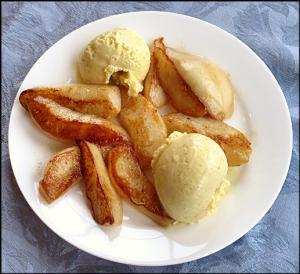Since late last month, we’ve been finding ways to enjoy a generous gift of beautiful Bartlett pears. When we first opened the box, the fruit was far too hard to eat. The green pears needed to be arranged on the countertop and given time to ripen. We tested them each morning by gently pressing at the base of the stem to assess their progress. Once the flesh yielded slightly, we knew they were at peak ripeness and should be eaten within a day or stored in the refrigerator.
Unlike other varieties of pears which don’t change color as they ripen, the Bartlett turns from light green to a golden hue, which gives you another clue about how soft and juicy the inside flesh has become. They can be eaten out of hand, sliced into salads, layered with ham and cheese in a sandwich, or simmered in butter to caramelize, as seen in the photo.
Many recipes for simmered or poached pears recommend the sturdier Bosc variety, which holds its shape better under heat. Bartletts are well-suited for pear butters or for baking into a pear tart or pie. But, since we had Bartletts and French vanilla ice cream on hand, into the skillet they went. Instead of leaving them in cored halves, I opted to cut them into slices so they would cook evenly. Perhaps not the prettiest plating, but the flavors were terrific.
Pears are native to the Caucasus region of what is now Europe and Asia. They have been cultivated for their sweet fruit since antiquity. From Asian literature to Homer’s “Odyssey,” pears have been lauded for their magical properties. In Spain, the colloquial expression “esto es la pera” (it’s the pear) refers to something exciting or wonderful. Through the centuries, they expanded their reach, and pears now encompass more than 1,000 different varieties.
Pears made an appearance in North America in the early 1600s in the form of seeds imported by the Massachusetts Company from England. Like apples, whose seeds do not produce specimens identical to their parents, these pear seeds were the forbears of a diverse variety of types now found in the United States. According to the website usapears.org, there are 10 common varieties cultivated by growers in this country.
The key thing to keep in mind about pears is that they are picked before they’re fully ripe, otherwise they would be entirely too tender to ship. Don’t be too aggressive with pears; they bruise easily, and nicking the skin invites browning. The challenge is how to reach the perfect degree of tenderness, juiciness and flavor without creating a mushy mess, hence the countertop inspection each morning as they ripened.
If you want to find a dish to make good use of less-than-lovely or slightly overripe specimens, consider trying a batch of pear butter. The technique in the recipe below avoids the tedium of peeling and coring the fruit. Grinding the chunks with a food mill extracts the juicy flesh, leaving behind the pits and skin. The two hours in the oven will thicken the puree and concentrate the flavors. Or, skip the baking step to make a pear version of applesauce, delicious over grilled pork chops.
The pear tea bread recipe takes a surprisingly long time to cook because the batter is so wet. If you make it, keep in mind that it’s easier to remove the pear skins with a vegetable peeler than a knife; you’ll lose less flesh (of both the pear and your fingers when dealing with such slippery fruit). Grating the pears over a bowl will let you catch every drop of the sweet juices to flavor the fragrant bread, and it’s also good with ice cream.
Caramelized Pears
2 pears
1 T butter
1 T sugar
1 t cinnamon
1 T orange juice
1/2 t vanilla
Peel and core the pears; quarter or slice, depending on the type of pear. If using Bosc, peel and quarter; if using Bartlett, peel and cut into 1-inch thick slices. Melt butter in a skillet over medium-low heat. Arrange pears in a single layer, cut sides down. Sprinkle with sugar and cinnamon. Cook until golden, turning often. As juices evaporate, stir in orange juice and vanilla. Continue to cook until fruit is softened but not mushy. Serve warm with ice cream or chocolate syrup. Yield: 2 servings.
Pear Tea Bread
1 1/2 C flour
2/3 C sugar
1 t baking soda
1/2 t salt
1/2 t cinnamon
1/4 t nutmeg
pinch ground cloves
1 egg
1/3 C canola oil
1 t vanilla
zest and juice of 1 lemon
6 ripe pears*
Preheat oven to 350 F. Coat the inside of a loaf pan with nonstick cooking spray; set aside. Combine the dry ingredients in a bowl; set aside. In a large mixing bowl, whisk together the egg, oil, vanilla, lemon juice and zest; set aside. Peel the pears and grate the flesh over a bowl to catch the juices. Add 1 1/2 C grated pears with juice to wet ingredients, stirring until mixture is smooth. Add the dry ingredients and fold together, just until combined. Pour batter into prepared pan and bake for 45 minutes. Turn the oven down to 325 F and continue baking until tester comes out clean, another 35 minutes. Cool in the pan for 10 minutes, then place loaf on rack to cool completely. *Note, use d’Anjou, Bartlett or other soft-fleshed pear.
Pear Butter
3 pounds very ripe pears*
2 t lemon juice
1/4 C sugar
1 t grated orange peel
Preheat oven to 300 F. Cut the pears into large chunks, removing any badly damaged flesh. There is no need to peel and core unless pears are not soft. Press the pears through a food mill into a large bowl. Stir in the lemon juice, sugar and orange peel. Pour the puree into a glass baking dish and cook for 2 hours, stirring every 30 minutes. Transfer the thickened pear butter into a bowl to cool. Store it in an airtight container in the refrigerator. *Note, use d’Anjou, Bartlett or a combination of both.
























































